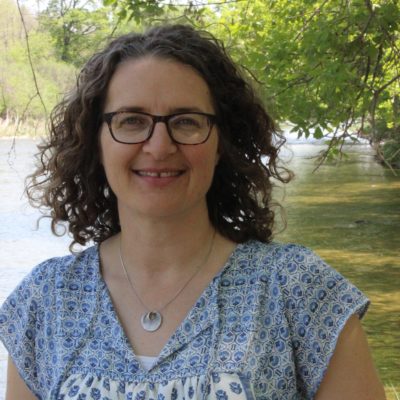By Jennifer Schrock
Wendy Janzen, Kitchener, Ont., is Mennonite Creation Care Network’s 2020 pick for its Art and Jocele Meyer Award. The annual award recognizes effective leadership in caring for the earth within congregations who relate to MCCN. It comes with a $500 award to further the ministries already in process.
The MCCN council selected Wendy because of her work with the forest or wild church movement. Wendy leads two forest churches in Ontario: Burning Bush Forest Church and Wilmot Forest Church, both in the Kitchener-Waterloo area. She also plays a key leadership role with the Wild Church Network, which she helped found.
Nature as beloved community
The term, “forest church,” comes from England where the movement originated. In North American contexts in which forests are not the local ecosystem, “wild church” has been chosen as a more fitting term. According to the Wild Church Network’s website, wild or forest churches are theologically diverse but share three commonalities. They understand nature as a beloved community, not a backdrop; they are from the Christ tradition, and they seek both inner and outer transformation. Worship happens outdoors, typically year-round, sometimes on foot.
Wendy’s gifts fertilize both Mennonite congregations and the Wild Church Network. Many Mennonite churches, particularly in Canada, have sought guidance from Wendy on what it means to worship with creation and how to do it. MCCN periodically reports on her work, and she has provided content for an MCCN webinar. Meanwhile, the Wild Church Network has likely benefited from Wendy’s groundedness in Anabaptist-Mennonite theology and the disproportionate number of Mennonites who have come into this network through her.
Explosive growth
Even before the pandemic, the Wild Church Network was growing. This year, it is “exploding,” Wendy says. A webinar in the fall drew over 100 people, and roughly a dozen new people are showing up every month at the welcome sessions that Wendy co-hosts.
Janet Bauman, who attends Burning Bush Forest Church, says she particularly appreciates the invitation to silence that is part of the worship experiences, in contrast to the word-oriented emphasis of indoor services. The church meets in a variety of park settings and begins with attention to the surroundings. Wendy presents a theme or question which then leads to contemplative time alone. The group gathers again for sharing, communion and prayer. For some present, it is a supplement to traditional worship; for others, it is their only contact with a church.
At times, Burning Bush bends its meeting time around what is happening in nature. At Easter, they’ve met at sunrise; once they met later than usual to take advantage of meteor showers. Another time, they floated down the Grand River together.
Both of the forest churches Wendy works with came into existence with the help of traditional Mennonite Churches. Burning Bush is associated with St. Jacobs Mennonite Church, St. Jacobs, Ont., where Wendy pastored until recently. The Wilmot Forest Church receives support from Wilmot Mennonite Church in the New Hamburg area. It was born when Wilmot’s pastor, Susan Alison Jones, saw a connection between Wendy’s work and her aging congregation’s desire to reach its community in ways they might find lifegiving.
Wendy bases both monthly gatherings on the same plan, but says the congregations have developed a different character. A volunteer within the Wilmot group provides children’s activities, and this draws families with children.
At a time when society is becoming increasingly secular and the timeworn models of church are not working for many people, Wendy is blazing a trail for us. At a time when environmental disasters loom, she is helping us to love and respect our fellow creatures and to discover a God who is present beyond the walls of our churches. Her influence extends well beyond the two forest churches she leads.
Art and Jocele Meyer challenged people of faith to think about the environment long before creation care and eco-justice were buzzwords. The couple is best known for their 1991 book, Earth-keepers: Environmental Perspectives on Hunger, Poverty and Injustice and for their work reclaiming strip-mined land.
